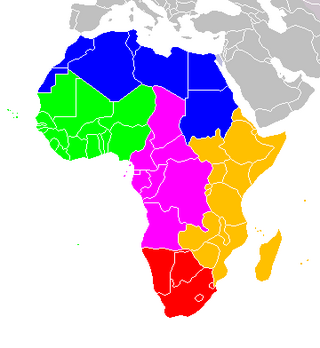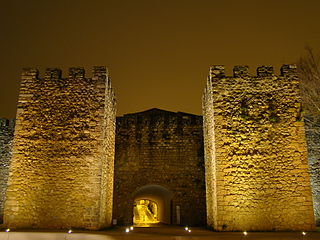
Dom Henrique of Portugal, Duke of Viseu, better known as Prince Henry the Navigator, was a central figure in the early days of the Portuguese Empire and in the 15th-century European maritime discoveries and maritime expansion. Through his administrative direction, he is regarded as the main initiator of what would be known as the Age of Discovery. Henry was the fourth child of King Dom John I of Portugal, who founded the House of Aviz.
1444 (MCDXLIV) was a leap year starting on Wednesday of the Julian calendar, the 1444th year of the Common Era (CE) and Anno Domini (AD) designations, the 444th year of the 2nd millennium, the 44th year of the 15th century, and the 5th year of the 1440s decade. As of the start of 1444, the Gregorian calendar was 9 days ahead of the Julian calendar, which was the dominant calendar of the time.

Lagos is a city and municipality at the mouth of Bensafrim River and along the Atlantic Ocean, in the Barlavento region of the Algarve, in southern Portugal. The population of the municipality in 2011 was 31,049, in an area of 212.99 km2. The city of Lagos proper has a population of approximately 22,000. Typically, these numbers increase during the summer months, with the influx of visiting tourists and seasonal residents. While the majority of the population lives along the coast and works in tourism and services, the inland region is sparsely inhabited, with the majority of the people working in agriculture and forestry.
Nuno Tristão was a 15th-century Portuguese explorer and slave trader, active in the early 1440s, traditionally thought to be the first European to reach the region of Guinea. Legend has it that he sailed as far as Guinea-Bissau, however, more recent historians believe he did not go beyond the Gambia River).
Antão Gonçalves was a 15th-century Portuguese explorer who was the first European to capture Africans in the Rio do Ouro region.

A slave market is a place where slaves are bought and sold. These markets became a key phenomenon in the history of slavery.

Diogo Gomes was a Portuguese navigator, explorer and writer. Diogo Gomes was a servant and explorer of Portuguese prince Henry the Navigator. His memoirs were dictated late in his life to Martin Behaim. They are an invaluable account of the Portuguese discoveries under Henry the Navigator, and one of the principal sources upon which historians of the era have drawn. He explored and ascended up the Gambia River in West Africa and discovered some of the Cape Verde islands.

The Casa da Índia was a Portuguese state-run commercial organization during the Age of Discovery. It regulated international trade and the Portuguese Empire's territories, colonies, and factories across Asia and Africa. Central to the Casa da Índia's objectives was the establishment and protection of a Portuguese mare clausum in the Atlantic Ocean, Indian Ocean, Arabian sea, and the Indies.

Sancho de Tovar, 6th Lord of Cevico, Caracena and Boca de Huérgano was a Portuguese nobleman of Castilian birth, best known as a navigator and explorer during the Portuguese age of discoveries. He was the vice-admiral (soto-capitão) of the fleet that discovered Brazil in 1500, and was later appointed Governor of the East African port-city of Sofala by king Manuel I. In this post, he conducted several exploratory missions in the interior regions of present-day Mozambique.

Portuguese Africans are Portuguese people born or permanently settled in Africa. The largest Portuguese African population lives in Portugal numbering over 1 million with large and important minorities living in South Africa, Namibia and the Portuguese-speaking African countries .The descendants of the Portuguese settlers who were born and "raised" locally since Portuguese colonial time were called crioulos. Much of the original population is unnumbered having been assimilated into Portugal, Brazil, and other countries.
Indians in Portugal, including recent immigrants and people who trace their ancestry back to India, together number around 80,000 -120,000. Between 2018 and 2022 around 32,000 Indians entered the country, settling mostly in Lisbon and Porto. They thus constitute 0.76% - 1.15% of the total population of Portugal.
Chinese people in Portugal form the country's largest Asian community, and the twelfth-largest foreign community overall. Despite forming only a small part of the overseas Chinese population in Europe, the Chinese community in Portugal is one of the continent's oldest due to the country's colonial and trade history with Macau dating back to the 16th century. There are about 30,000 people of Chinese descent residing in Portugal

Slavery in Portugal existed since before the country's formation. During the pre-independence period, inhabitants of the current Portuguese territory were often enslaved and enslaved others. After independence, during the existence of the Kingdom of Portugal, the country played a leading role in the Atlantic slave trade, which involved the mass trade and transportation of slaves from Africa and other parts of the world to the American continent. The import of slaves was banned in European Portugal in 1761 by the Marquês de Pombal. However, slavery within the African Portuguese colonies was only abolished in 1869.
Lançarote de Freitas, better known as Lançarote de Lagos or Lançarote da Ilha, was a 15th-century Portuguese explorer and slave trader from Lagos, Portugal. He was the leader of two large Portuguese slaving raids on the West African coast in 1444–46.
Gonçalo de Sintra or de Cintra (d.1444/45), was a 15th-century Portuguese explorer and servant of Prince Henry the Navigator.

The Castle of Lagos is a medieval castle located in the municipality of Lagos, Portugal. Its walls surrounded the entire city of Lagos, providing the town its main means of defence.

Japanese–Portugal relations are the foreign relations between Japan and Portugal. Although Portuguese sailors visited Japan first in 1543, diplomatic relations started in the nineteenth century.

The School of Sagres, also called Court of Sagres is supposed to have been a group of figures associated with fifteenth century Portuguese navigation, gathered by prince Henry of Portugal in Sagres near Cape St. Vincent, the southwestern end of the Iberian Peninsula, in the Algarve.

Ana Vicente was an Anglo-Portuguese writer with a strong Catholic faith, known for her support for feminist causes.

Paula Escarameia was a Portuguese jurist. She was the first woman to be elected by the United Nations General Assembly to the International Law Commission (ILC).














